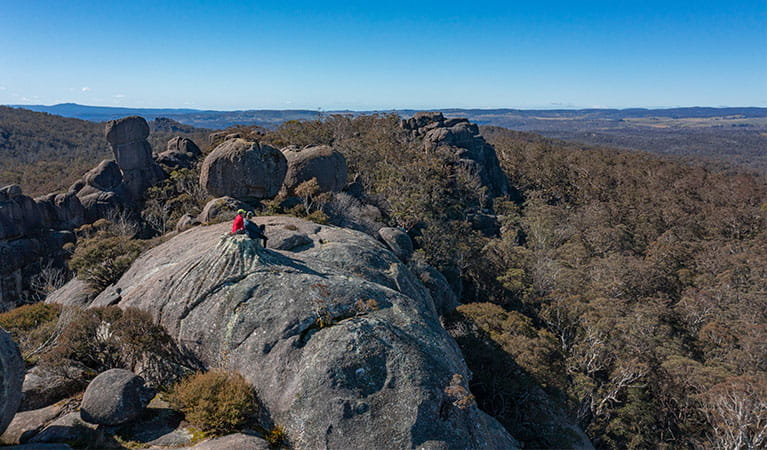Cathedral Rock National Park
Overview
Camp, walk, birdwatch and enjoy scenic views with great picnic spots at Cathedral Rock National Park, just east of Armidale and west of Dorrigo on the New England Tablelands.
Read more about Cathedral Rock National Park
Rock-hopping isn’t just for the wallaroos at Cathedral Rock National Park. Hike to the park’s main boulder piles of Woolpack Rocks and Cathedral Rock and scramble to their summits. Then enjoy the superb views across the wilderness landscape of dry eucalypt forest and granite outcrops. The park’s rock formations are particularly photogenic in late-afternoon light or mist.
Take short walks from the campgrounds, or do a long hike between them. For an exhilarating challenge, you can carry your pack for the 10.4km Barokee to Native Dog Creek walk, camp at the other end, and retrace your steps later.
Whether you’re visiting the park for a picnic lunch or camping for a few days, there are plenty of birdwatching opportunities. The screech of the glossy black cockatoo lets you know there’s a flock overhead. You may be fortunate enough to spot the endangered turquoise parrot, and remember to look out for the wedge-tailed eagle silently circling the granite tors.
Local alerts
For the latest updates on fires, closures and other alerts in this area, see https://www.nationalparks.nsw.gov.au/visit-a-park/parks/cathedral-rock-national-park/local-alerts
Contact
- in the Country NSW region
Cathedral Rock National Park is always open, but may have to close at times due to poor weather or fire danger.
-
-
Glen Innes office
02 6739 0700
Contact hours: Monday to Friday, 8.30am to 4.30pm. - 68 Church Street, Glen Innes NSW 2370
-
Email: npws.ntab@environment.nsw.gov.au
-
Glen Innes office
Visitor info
All the practical information you need to know about Cathedral Rock National Park.
Map
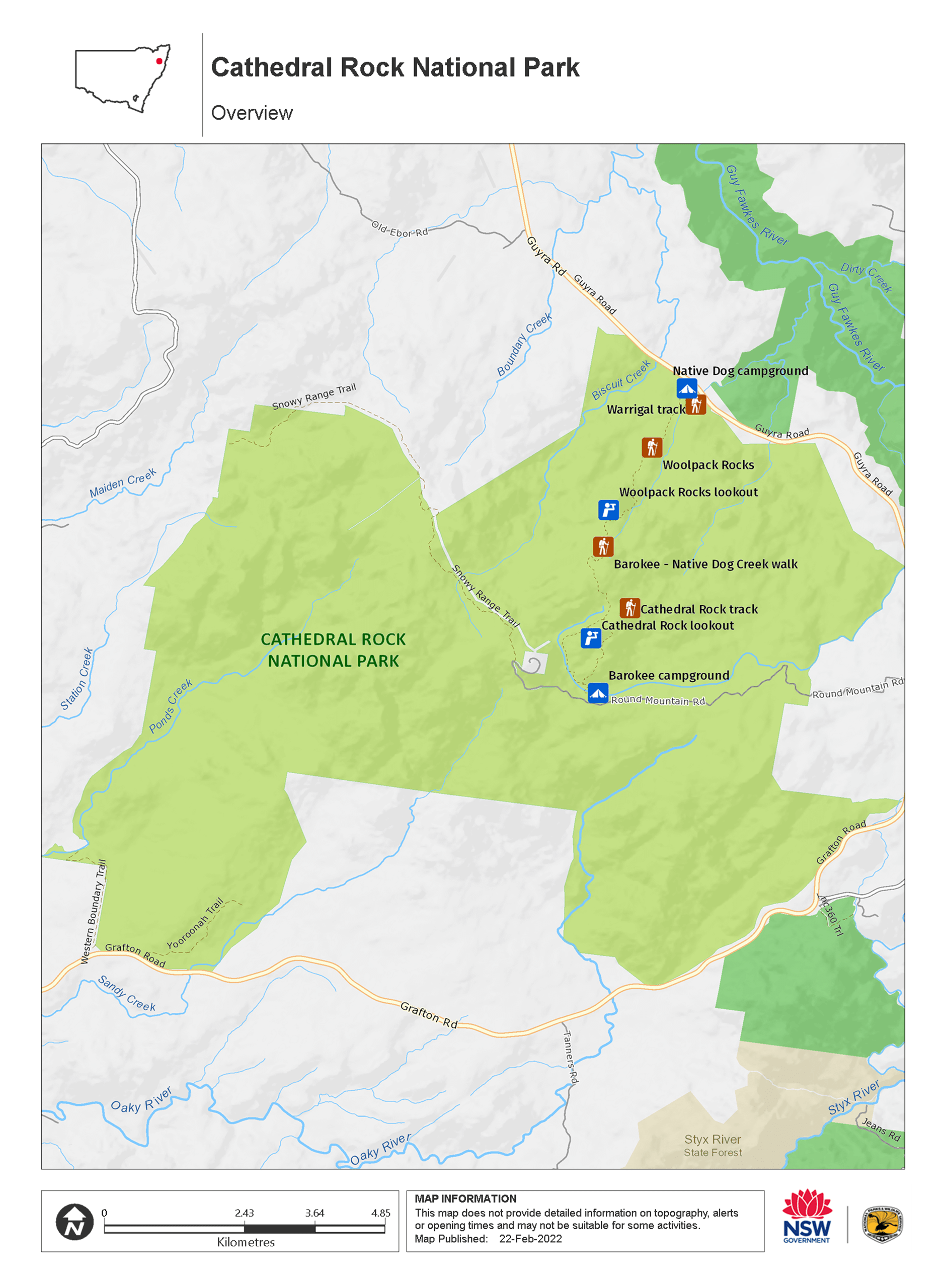
Map legend

Getting there and parking
Get driving directions
From Armidale:
- Drive east on Barney Street, which soon becomes Grafton Road and later Waterfall Way (all State Route 78) for 70km, passing through Argyle and Wollomombi.
- To access Barokee campground, take the Round Mountain Road turnoff on the left and after 8km of narrow gravel road, turn right into the campground.
- To access Native Dog campground, which is in the northern section of the park, continue for a few more kilometres along Waterfall Way (78) until it intersects with Guyra Road and then turn left. After 10km, the entrance is on the left and there is a short gravel road into the campground.
From Dorrigo:
- Drive west on Grafton Road/Waterfall Way (State Route 78) for 50km, passing through the village of Ebor, until the road intersects with Guyra Road.
- To access Barokee campground, which is in the central section of the park, turn left at the intersection with Guyra Road to remain on Waterfall Way (78). A couple of kilometres later, turn right into Round Mountain Road. After 8km of narrow gravel road, turn right into the campground.
- To access Native Dog campground, continue straight ahead onto Guyra Road. After 10km, the entrance is on the left and there is a short gravel road into the campground.
Parking
- Barokee campground See on map
- Native Dog campground See on map
Road quality
- Unsealed roads
Vehicle access
- 2WD vehicles
Weather restrictions
- All weather
By bike
Check out the Bicycle information for NSW website for more information.
Best times to visit
There are lots of great things waiting for you in Cathedral Rock National Park. Here are some of the highlights.
Autumn
Within the tall, moist forest, kangaroos poise in the mist amongst granite boulders as morning light streams through the canopy,making this the ideal time of year to capture that perfect photograph.
Spring
Feast your eyes on this season's wildflower displays, when heath shrub and ground plants show you what they're really made of. Bring your walking shoes and a macro lens.
Summer
The relatively high altitude of the park offers cool respite from the summer heat of the region's western slopes and coastal lowlands.
Winter
Rug up and come prepared as winter temperatures plunge overnight. The rewards for braving the cold are sparkling frosty mornings and clear sunny days. Winter is also the peak time for the male lyrebird to call with most intensity as he courts a mate.
Weather, temperature and rainfall
Summer temperature
Average
11.5°C and 23°C
Highest recorded
32.8°C
Winter temperature
Average
1°C and 11°C
Lowest recorded
-7°C
Rainfall
Wettest month
January
Driest month
June
The area’s highest recorded rainfall in one day
84mm
Facilities
Toilets
Picnic tables
Barbecue facilities
Maps and downloads
Prohibited
Pets
Pets and domestic animals (other than certified assistance animals) are not permitted. Find out which regional parks allow dog walking and see the pets in parks policy for more information.
Smoking
NSW national parks are no smoking areas.
Nearby towns
Dorrigo (55 km)
Dorrigo is a serene country town and the gateway to Dorrigo National Park. Its close to the edge of the escarpment above the Bellingen Valley.
Armidale (75 km)
During autumn the parks and gardens around Armidale show their beautiful colours. Enjoy a drive along the Waterfall Way, stopping at waterfalls and craggy gorges in the rugged countryside.
Guyra (113 km)
Fishing in one of Guyra's numerous and beautiful streams is a great way to relax and get back to nature. You might land a big trout, too! If you're looking for more active pursuits, you're within easy reach of a number of scenic national parks, where rock climbing, kayaking horseriding and bushwalking are just some of your options.
Learn more
Cathedral Rock National Park is a special place. Here are just some of the reasons why:
Walking experiences for all levels
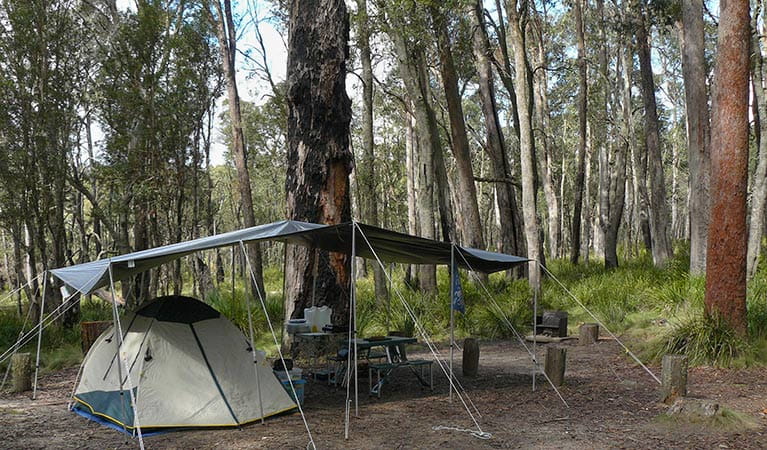
From a stroll to a scramble, there are plenty of walking opportunities in Cathedral Rock National Park. Hiking tracks are easily accessible from the campgrounds and the longest track - Barokee to Native Dog Creek walk - can be started from either end. Cathedral Rock track is a medium-difficulty walk, and will take you almost three hours. And there are off-track opportunities for those who are experienced, well-equipped, and walking as part of a group.
Rich with colour and biodiversity
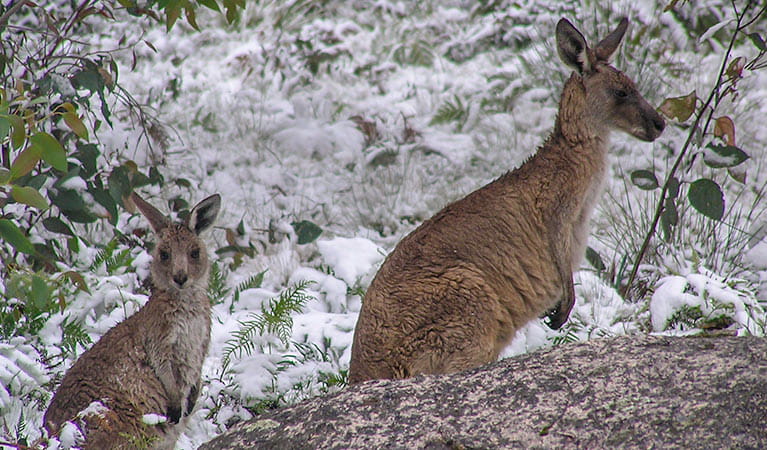
Flax lily, pixie cap and wax lip are just some of the flowering plants and understory shrubs you'll find in Cathedral Rock National Park. Most wildflowers emerge in spring, but ground orchids bloom at various times of the year, and banksias display their orange flowers year-round. Keep a particular eye out for the Montane green five-corners - this threatened plant only grows on granite soils in or near the park. You'll also find concentrated areas of wattle, where broad-leaf hickory, silver and fern leaf wattle flower in late winter and early spring. Eastern grey kangaroos graze in the open grassy areas of the park alongside red-necked and swamp wallabies and wallaroos. Other wildlife you're likely to spot here are glossy black cockatoos, skinks, wedge-tailed eagles and rose robins by day, and the threatened brush-tailed phascogales and spotted-tailed quolls by night.
- Barokee to Native Dog Creek walk This track is the longest in Cathedral Rock National Park. It links Barokee and Native Dog campgrounds and takes in both Woolpack Rocks and Cathedral Rock along the way.
- Warrigal walking track Warrigal walking track, close to Native Dog campground in Cathedral Rock National Park, is a short, easy walk that’s popular with families and those who enjoy birdwatching.
270 million years in the making
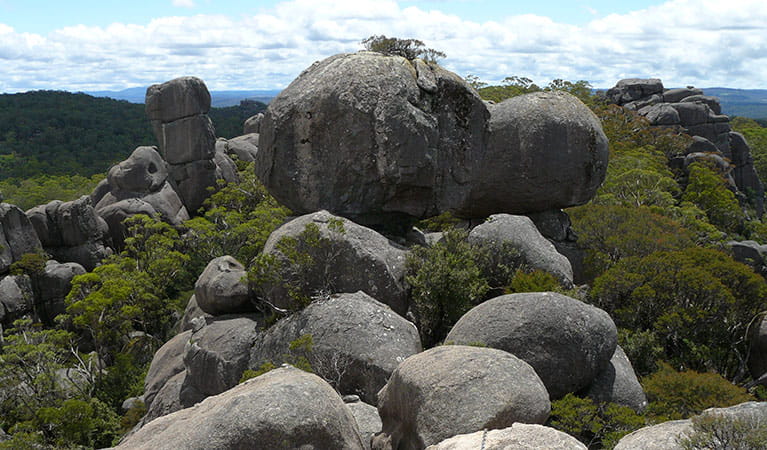
The granites of the New England batholith, which formed deep beneath the earth's surface 270 million years ago, dominate Cathedral Rock National Park. For the next 50 million years, further intrusions of molten rock were forced into fissures deep within the earth's crust, forming some of the dykes evident in the park today. Weathering has exposed large granite tors - most notably, Cathedral Rock, a series of large granite boulders perched one on top of another to a height of about 200m and extending approximately 1km. The most recent geological feature in the park is the basalt-capping on the summit of Round Mountain, a domed peak in the centre of the park. These basalt flows originated in the Ebor volcano, centred to the east of Point lookout, which was active around 18 million years ago.
- Cathedral Rock track Cathedral Rock track is an exciting and challenging walk, near to Barokee campground and Round Mountain, offering scenic views across the New England Tablelands from the summit.
- Warrigal walking track Warrigal walking track, close to Native Dog campground in Cathedral Rock National Park, is a short, easy walk that’s popular with families and those who enjoy birdwatching.
- Woolpack Rocks Starting from Native Dog campground, follow this track to Woolpack Rocks, where you can picnic, birdwatch and walk to the summit for views across the New England Tablelands.
Education resources (1)
What we're doing
Cathedral Rock National Park has management strategies in place to protect and conserve the values of this park. Visit the OEH website for detailed park and fire management documents.
Understanding landscapes and geology
Cathedral Rock National Park values the protection and conservation of biodiversity, land and native vegetation. NPWS carries out a range of ongoing initiatives, designed to minimise negative impacts to the park’s delicate features and landscapes. Monitoring and, where required, rehabilitation of significant areas are ongoing in this park.
Preserving biodiversity
Cathedral Rock National Park, known for its sensitive and diverse landscapes, is committed to preserving biodiversity. NPWS embraces programs that work to conserve the integrity and diversity of the park’s native vegetation communities. Efforts to minimise threats to such significant communities are ongoing, and may include monitoring and fire management strategies.
Developing visitor facilities and experiences
NPWS is committed to providing ample facilities for visitors to enjoy. Cathedral Rock National Park frequently evaluates its visitor offerings to ensure park visitors are well catered for. Tourist accommodation, including national park campgrounds, is regularly reviewed, serviced and maintained to a high standard, with visitor feedback considered and incorporated wherever possible.

